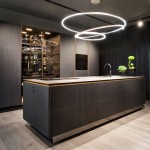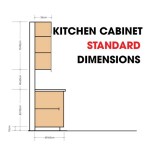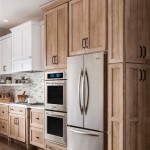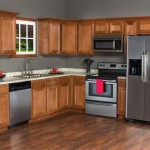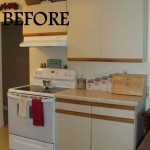Wood for Kitchen Cabinets: A Comprehensive Guide
The selection of wood for kitchen cabinets is a pivotal decision in any kitchen renovation or new construction project. Wood cabinets are celebrated for their natural beauty, durability, and versatility, contributing significantly to the overall aesthetic and functionality of the kitchen space. Understanding the various wood species, their properties, and their suitability for kitchen applications is crucial for making an informed choice that aligns with both budget and design preferences.
This article explores the diverse range of wood options available for kitchen cabinets, examining their characteristics, benefits, and considerations in the context of kitchen design and environmental factors. The goal is to provide a comprehensive overview that enables homeowners, designers, and contractors to make well-informed decisions regarding the selection of wood for their kitchen cabinetry.
Hardwood vs. Softwood: Understanding the Core Differences
A fundamental distinction in wood classification lies between hardwoods and softwoods. This classification is based on the tree’s reproductive structure, not necessarily the actual hardness of the wood. Hardwoods generally come from deciduous trees, which lose their leaves annually, while softwoods originate from coniferous trees, which typically remain evergreen. While certain hardwoods are indeed harder than certain softwoods, the terms are primarily botanical designations.
Hardwoods are known for their density, durability, and intricate grain patterns. They are generally more resistant to dents and scratches, making them a popular choice for high-use areas like kitchen cabinets. Common hardwoods used in cabinet making include maple, oak, cherry, and walnut. These woods offer a wide range of colors and grain patterns, allowing for diverse aesthetic possibilities.
Softwoods, on the other hand, are typically less expensive and easier to work with. They are often lighter in color and have a more uniform grain pattern. Pine, fir, and cedar are common softwood options. While softwoods can be used for kitchen cabinets, they are generally more susceptible to damage and may require more maintenance. They are often preferred where a rustic or painted finish is desired, as the wood's natural grain is less prominent.
The choice between hardwood and softwood depends on several factors, including budget, desired aesthetic, durability requirements, and planned finish. Hardwoods are generally a more premium option, offering greater longevity and resistance to wear and tear. Softwoods, while more affordable, may require more careful handling and maintenance to ensure their long-term integrity in a kitchen environment.
Popular Hardwood Choices for Kitchen Cabinets
Several hardwood species stand out as particularly well-suited for kitchen cabinets, each offering a unique combination of beauty, durability, and workability.
Maple: Maple is a popular choice due to its hardness, durability, and relatively neutral color. It has a fine, even grain that accepts paint and stain well, making it highly versatile for various kitchen styles. Maple is also a cost-effective option compared to some other hardwoods, providing excellent value for its performance.
Oak: Oak is a classic choice known for its distinctive grain pattern and strength. There are two main types of oak: red oak and white oak. Red oak has a more pronounced grain and a pinkish hue, while white oak is denser, more water-resistant, and has a warmer, brownish tone. Oak is a durable and long-lasting option, suitable for both traditional and contemporary kitchens.
Cherry: Cherry is prized for its rich, reddish-brown color and smooth grain. It is a beautiful and elegant wood that adds warmth and sophistication to any kitchen. Cherry naturally darkens over time, developing a deeper, richer patina. While softer than maple or oak, cherry is still a durable choice for kitchen cabinets, especially when properly finished and maintained.
Walnut: Walnut is a luxurious and expensive hardwood known for its deep, chocolate-brown color and striking grain patterns. It is a strong and stable wood that holds its shape well, making it ideal for intricate cabinet designs. Walnut adds a touch of elegance and sophistication to any kitchen, but its higher price point makes it a less common choice for entire kitchens. It's often used for accent pieces or islands.
Hickory: Hickory is one of the hardest and most durable domestic hardwoods. It has a pronounced grain pattern and can range in color from creamy white to reddish-brown. Hickory is a strong and resilient choice for kitchen cabinets, particularly in high-traffic areas or where durability is a primary concern. Its rustic appearance makes it well-suited for country or farmhouse-style kitchens.
Each of these hardwoods offers a unique aesthetic and performance profile. The selection should be based on desired color, grain pattern, durability requirements, and budget considerations.
Beyond Solid Wood: Alternatives and Considerations
While solid wood is often considered the gold standard for kitchen cabinets, several alternatives offer cost savings or enhanced stability, while still providing a beautiful and functional result. These alternatives include plywood, medium-density fiberboard (MDF), and particleboard.
Plywood: Plywood is made by layering thin sheets of wood veneer, glued together with the grain running in alternating directions. This construction provides exceptional strength and stability, making plywood less prone to warping or cracking than solid wood. Plywood is a popular choice for cabinet boxes and shelves due to its durability and resistance to moisture. When a hardwood veneer is applied to plywood, it can achieve a similar look to solid wood cabinets at a lower cost.
Medium-Density Fiberboard (MDF): MDF is an engineered wood product made from wood fibers, resin, and wax, pressed together under high pressure and heat. MDF is a smooth, dense material that is ideal for painted cabinets. It is less prone to expansion and contraction than solid wood, making it a stable choice in humid environments. MDF is also less expensive than solid wood and plywood. However, MDF is susceptible to water damage and should be properly sealed and protected from moisture.
Particleboard: Particleboard is another engineered wood product made from wood chips, sawdust, and resin, pressed together. It is the least expensive option but also the least durable. Particleboard is often used for cabinet boxes in budget-friendly kitchens. It is highly susceptible to water damage and is not recommended for areas prone to moisture. Particleboard is typically covered with a laminate or veneer to provide a more attractive and durable finish.
When considering these alternatives, it is important to weigh the cost savings against the potential trade-offs in durability and moisture resistance. Plywood with a hardwood veneer offers a good balance of cost and performance, while MDF is an excellent choice for painted cabinets. Particleboard is generally best avoided in areas prone to moisture or high use.
Furthermore, the industry trend toward sustainability has fostered the development of composite wood products that incorporate recycled wood fibers and low-emission adhesives. These products offer environmentally conscious alternatives that can contribute to a healthier indoor environment.
Understanding Wood Grades and Finishing Options
The grade of wood refers to its appearance and the presence of knots, mineral streaks, and other natural variations. Higher-grade woods have fewer imperfections and a more uniform appearance, while lower-grade woods may have more knots and variations in color and grain. The wood grade significantly influences the final appearance of the cabinets.
Select Grade: This is the highest grade of wood, with minimal knots and imperfections. Select grade wood is typically used for high-end cabinets where a uniform and consistent appearance is desired. It is the most expensive grade.
Common Grade (or #1 Common): This grade has more knots and imperfections than select grade, but it is still a good-quality wood for cabinets. Common grade wood can be used to create a more rustic or character-rich look. It is less expensive than select grade.
Rustic Grade: This grade has the most knots, imperfections, and variations in color and grain. Rustic grade wood is often used in country or farmhouse-style kitchens where a natural and aged appearance is desired. It is the least expensive grade.
The finish applied to the wood also plays a crucial role in its appearance and durability. Common finishing options include:
Staining: Staining enhances the natural grain of the wood and adds color. A stain can be applied to highlight the wood's natural beauty or to create a specific aesthetic. Staining requires a topcoat of sealant to protect the wood from moisture and wear.
Painting: Painting provides a uniform color and hides the wood's grain. Painted cabinets are a popular choice for modern and contemporary kitchens. A primer is typically applied before painting to ensure proper adhesion and coverage.
Sealing: Sealing protects the wood from moisture, stains, and scratches. A sealant can be applied over stain or paint, or directly to the wood for a natural look. Common sealants include polyurethane, lacquer, and varnish.
Clear Coating: A clear coat finish enhances the natural beauty of the wood while providing a protective layer. It allows the natural wood grain and color to shine through, offering a subtle sheen.
Choosing the right finish is essential for both the aesthetic appeal and the longevity of kitchen cabinets. A durable and well-applied finish can protect the wood from the harsh conditions of the kitchen environment, including moisture, grease, and wear and tear.
Impact of Wood Species on Kitchen Design Style
The choice of wood species significantly influences the overall style and aesthetic of the kitchen. Different wood species lend themselves to various design styles, from traditional to contemporary.
Traditional Kitchens: Classic wood species like oak, cherry, and walnut are often used in traditional kitchens. These woods have a rich, warm color and a distinctive grain pattern that complements traditional design elements such as raised-panel doors, intricate moldings, and antique hardware.
Contemporary Kitchens: Maple, with its clean lines and neutral color, is a popular choice for contemporary kitchens. It can be stained or painted to achieve a sleek and modern look. Flat-panel doors, minimalist hardware, and a focus on clean lines are characteristic of contemporary kitchen design.
Farmhouse Kitchens: Rustic wood species like pine and hickory are well-suited for farmhouse kitchens. These woods have a natural, aged appearance that complements the rustic charm of farmhouse style. Distressed finishes, shaker-style doors, and vintage hardware are common elements in farmhouse kitchens.
Transitional Kitchens: Transitional kitchens blend traditional and contemporary elements. Wood species like maple, oak, and cherry can be used in transitional kitchens, depending on the desired balance between classic and modern design. A combination of raised-panel and flat-panel doors, along with a mix of traditional and contemporary hardware, is often seen in transitional kitchens.
Eclectic Kitchens: Eclectic kitchens embrace a mix of styles and materials. A variety of wood species can be used in eclectic kitchens to create a unique and personalized look. Pairing different wood species, finishes, and hardware can add visual interest and personality to an eclectic kitchen design.
The selection of wood species should be carefully considered in relation to the desired kitchen style and overall design vision. The wood's color, grain pattern, and texture can all contribute to the character and atmosphere of the kitchen space.
Cost Considerations and Budgeting for Wood Cabinets
The cost of wood kitchen cabinets can vary greatly depending on the wood species, grade, construction method, and finish. It is essential to establish a budget early in the planning process to avoid overspending.
Wood Species: Hardwoods like walnut and cherry are generally more expensive than hardwoods like oak and maple. Softwoods like pine are typically the least expensive option.
Wood Grade: Select grade wood is the most expensive, while rustic grade wood is the least expensive. Choose a grade that aligns with your budget and desired aesthetic.
Construction Method: Solid wood cabinets are generally more expensive than cabinets made from plywood or MDF. Consider the trade-offs between cost and durability when selecting a construction method.
Finish: Custom finishes, such as glazing or distressing, will add to the cost of the cabinets. A simple stain or paint finish is typically less expensive.
Cabinet Style Intricate cabinet designs with carvings, moldings, or special features will increase the cost of the cabinets. Simple, streamlined designs are typically less expensive.
To stay within budget, consider the following tips:
Mix and Match Materials: Use more expensive wood species for focal points, such as the kitchen island, and less expensive materials for other cabinets.
Opt for Plywood Boxes: Plywood offers a good balance of cost and durability for cabinet boxes.
Choose a Simple Finish: A simple stain or paint finish can be just as beautiful as a more elaborate finish.
Shop Around: Get quotes from several different cabinet manufacturers and compare prices.
Consider Stock or Semi-Custom Cabinets: Stock cabinets are pre-made and readily available, while semi-custom cabinets offer some customization options. Both are typically less expensive than custom cabinets.
By carefully considering these cost factors and budgeting strategies, it is possible to achieve beautiful and functional wood kitchen cabinets without breaking the bank.

Best Wood For Kitchen Cabinets Cabinet Materials Custom

Best Wood Types For Kitchen Cabinets Cabinet

12 Kitchens That Wow With Wood Cabinets

The Ultimate Guide To Wood Kitchen Cabinets For Any Style

Types Of Wood For Kitchen Cabinets Lily Ann

The Comeback Of Wood Kitchen Cabinets Farmhousehub

House Home See How Warm Wood Wows In These 75 Kitchens Bathrooms
Ultimate Guide To Wood Kitchen Cabinets Vevano

The Most Durable Kitchen Cabinets And Cabinet Finishes

Guide To Kitchen Cabinet Wood Types
Related Posts

